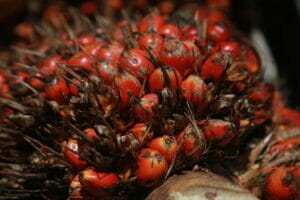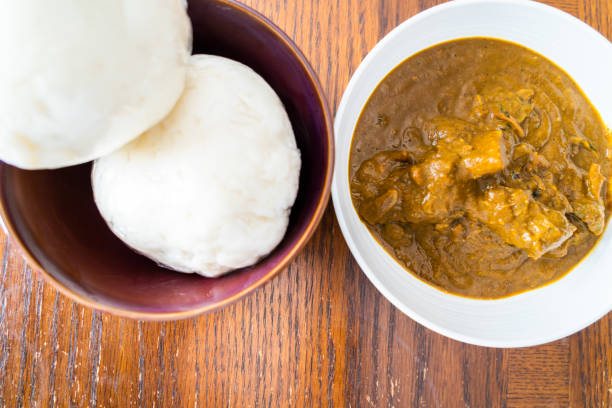Banga soup is a popular delicacy eaten by the Urhobo people of Delta State, Nigeria. The soup is prepared using Banga fruits, also known as palm fruit.
If you’ve ever tasted the Banga soup before, you know it’s incredibly delicious. A properly prepared Banga soup will leave its taste in your mouth for days!!
Yes, it’s that good!
However, Banga soup is a very complex soup to make. It requires both energy and patience. Do you recall that stuff they say about the patient dog eating the fattest bone?
Well, Banga soup is the proverbial ‘fattest bone’. You have to be patient if you plan to eat a properly prepared Banga soup.
If you wish to eat Banga soup, you need to be ready to dedicate a few hours to its preparation. Yes, it involves plenty of work, it’s labour-intensive
The soup goes by various names across, some of these names include,
Ofe Aku
Banga soup
Palm nut soup
Mbanga in Cameroon,
Abenkwan in Ghana
Moambe in Congo
Just as Banga soup goes by different names across Africa, it’s also prepared differently. However, in this article, we’ll be discussing how to prepare palm nut soup the way.
Before we dive into the ‘How to prepare Banga soup?’ question, let’s address the ‘what is Banga?’ question.
So,
What is Banga nut?
Banga nut, also known as palm kernel nut, is a nut gotten from the palm tree. It’s an edible seed that’s also a fruit.

Yes, some people can’t seem to figure out if it’s a fruit or a nut.
However, palm kernel nuts can be classified as seeds or fruit. The nuts were originally grown in Africa, however, they’ve spread to other parts of the world.
The nuts generally thrive in tropical regions. Due to how important and useful the nut is, it’s the most important oil-producing fruit in Africa and other parts of the world where it’s grown.
It has multiple uses but 90-95% of the oil extracted from the palm fruit is eaten. The palm tree can live for as long as a century and produce fruits for up to 35years.
A single palm tree can produce up to 70kg of palm oil. It takes between 5-6 months for the seed to mature.
On a global scale, up to 65 million tons of palm oil are produced each year.
Now that we know what Banga is, let’s discuss the various uses of palm kernel fruit.
Uses of Palm Kernel Fruit ( Banga nut)
Palm kernel nuts have a wide variety of uses. This is why it’s such a priced nut in the tropical region and around the world. In this section, we’ll be discussing the different uses of the palm kernel nut.
Here are some of the uses of palm kernel:
1. Palm oil
Palm oil is extracted from the outer skin of the nut. This oil can be cooked and made into hair cream, body cream, and soaps.
2. Confectionaries
Palm kernel oil is used for baking edibles like bread, biscuits, and cakes.
3. Production of cosmetics
Palm oil is an important ingredient used in the production of different cosmetics. Cosmetics such as soaps, hair creams, detergents, body lotion, etc.
4. Pharmaceutical uses
Palm oil has a wide range of medicinal properties. This is why it’s used in the production of many pharmaceutical products.
5. Fuel
Interestingly, palm oil can be used as fuel for cars. Locally, the palm kernel shell is used as a source of heat for cooking. The oil is also used as a lubricant.
Since we’ve established the fact that palm kernel nuts are useful, let’s explore the nutritional benefits and the general benefits of the nut.
8 Health Benefits of Palm Kernel Nuts
For this nut to have this number of economical uses, it must also have a wide range of benefits. In this section, we’ll be looking at the benefits of the palm kernel.
1. Reduces blood lipid levels: Palm oil has zero cholesterol in it. This makes it an ideal replacement for vegetable oil in the cooking process. The reduction of cholesterol and triglyceride in the bloodstream helps to protect the body from heart-related diseases.
2. Rich antioxidant properties: It’s rich in vitamin E, tocotrienols, and other antioxidants. These antioxidants make palm oil a natural anti-ageing agent that softens the skin and gets rid of wrinkles. This gives your skin a youthful appearance.
This is why it’s a key ingredient in various skin products. It helps in the neutralization of free- radicals in the body. These antioxidants also protect the skin from the ultraviolet rays of the sun. This helps to prevent cancer and detoxify the bloodstream.
3. Palm oil is a rich source of vitamin K: Vitamin K is a fat-soluble vitamin found abundantly in palm oil. Its anticoagulant properties aid in blood clotting, bone metabolism, and regulating blood calcium levels. Vitamin K helps in wound healing. This is one of the major reasons palm oil is recommended for daily use.
4. No Trans-Fat: This is one of the major benefits of palm oil that makes it ideal for cooking. It’s also helpful in weight loss.
5. Improved vision: The high content of vitamin A in palm oil helps to improve eye vision. Vitamin A is an important vitamin needed by the eye to prevent eye disorders.
6. Improved hair growth: Yup, you read that right. Palm oil isn’t only good for your skin and general body health, it also improves hair growth. It helps to improve hair thickness and prevents hair loss by protecting the hair from harsh conditions. Palm oil also provides the hair with needed nourishment.
7. Antiseizure properties: It’s believed that palm oil is a great remedy for epilepsy and seizures. It’s locally used in the treatment of convulsion in little children. It’s also believed that palm oil helps to prevent epileptic attacks.
8. Improves blood flow and reduces the risk of hypertension: Palm oil helps in the seamless flow of blood in the blood vessel. When blood flows freely in the blood vessel, the pressure of blood from the heart to other parts of the body is controlled. This controlled flow of blood helps to prevent hypertension.
Now that we’ve gotten an understanding of the health benefits of palm oil and its numerous uses, let’s talk about how to prepare Banga soup.
How to prepare Banga soup
Here are the ingredients used in the preparation of Banga soup:
Banga nut: You’ll extract the oil from the skin on the nut. This is why the soup is labour-intensive.
Banga spice: blend ataiko and irugeje together, this mixture creates wonderful spice for this soup.
Leaf: you can make use of scent leaf or bitter leaf, it’s your choice.
Oburunbebe stick/ Banga stick: this is a wooden stick with a striated bark. It can be used whole or grounded for the soup.
Crayfish: the crayfish should be grounded.
Prawns, periwinkle, or any other seafood of choice
Meat: goat meat or cow meat is the ideal choice of protein for this soup. The meat can be boiled or roasted.
Fresh Fish: The popular fish used for this dish is fresh catfish. However, another fresh fish will do.
Smoked fished: nicely smoked fish is also needed to bring out the glory of this soup.
Red pepper and stitches bonnet: you can use any colour of the scotch bonnet.
Seasoning cubes
Beef stock
Water
Onions
Salt
Step-by-step process of preparing Banga soup
- Season the meat/fish and dried fish
- Season the meat/fish and dried fish in a single pot. Boil them together till the meat is soft and tender. Then extract the stock from the meat and fish.
- Measure out your palm nuts
- Measure out the desired quantity of palm nuts.
- Wash the nuts thoroughly under running water.
- Place the washed palm nuts in a pot and cover it up with water.
- Boil the but till the skin is tender
- Pound the nut and extract the palm oil
- Transfer the tender nuts into a mortar and use the pestle to pound them
- Pound till the nuts look mushy
- Transfer the nuts into a large bowl and pour warm water on them.
- Use your hands to squeeze the oil out of the nuts.
- You’ll need to keep squeezing and transferring the nuts into bowls till all the oil has been extracted.
- Strain the water from the nuts into a pot.
- Boil the extract till it becomes a thick and viscous liquid. This will serve as the concentrate for the soup.
- Add the other ingredients
- Add the blended scotch bonnet and pepper mix
- Add desired seafood
- Add meat
- Add smoked fish
- Add meat/fish stock and let the soup cook for 10-15 minutes ( add more stock if the soup is too thick)
- Add blended crayfish
- Add seasoning cubes to desired taste.
- Add Banga spices
- Add Banga stick or powder
- Add salt to taste
- Leave to cook for another 10 minutes
- Add fresh fish ( it’s added now to prevent the fish from disintegrating in the pot)
- Add scent leaf or bitter leaf
- Leave the soup to cook for 5 minutes then bring the pot down from the gas.
- Serve: Now that your Banga soup is ready, serve it.
CONCLUSION: They say good things come to those who wait. Although labour-intensive, Banga soup is a sumptuous reward to those who wait!



